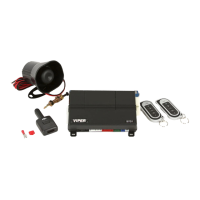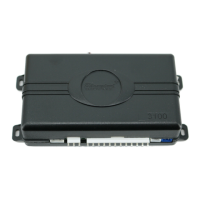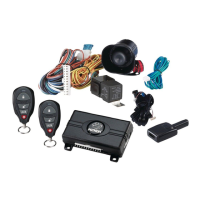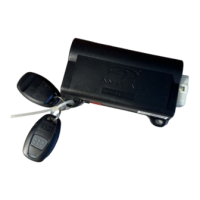Do you have a question about the Directed Electronics VIPER 3203 and is the answer not in the manual?
Welcomes the user and congratulates them on their new security system.
Lists all components provided with the vehicle security system package.
Provides comprehensive information regarding the product's warranty coverage and terms.
Explains the purpose and utility of the included quick reference card.
Instructions and information for purchasing replacement or additional remote controls.
Explains symbols, bold text, and italics used to navigate and understand the manual.
Details the physical components and core functionalities of the Responder LE remote.
Describes the control center unit, its antenna, LED indicator, and control button.
Explains how system commands are issued and how the system confirms their reception.
Step-by-step guide on how to perform various system commands using the remote.
A comprehensive table summarizing all available remote control commands and their functions.
Procedures for arming, disarming, and panicking the vehicle security system.
Procedures for performing arming and disarming without audible alerts.
How to use and control the AUX 1 function of the security system.
Steps and methods for bypassing system sensors when needed.
Instructions on how to engage and disengage the vehicle's valet mode.
How to use and control the AUX 2 function of the security system.
How to retrieve and understand the current status of the security system.
Performing silent arming while maintaining sensor-based alerts.
Locating the vehicle using the system's car finder function.
How to use and control the AUX 3 function of the security system.
Arming the system with maximum discretion, avoiding all external alerts.
How to use and control the AUX 4 function of the security system.
A guide to customizing various features and settings of the remote controls.
Instructions for adding and pairing new remote controls with the security system.
Initial setup steps required for the remote control to function correctly.
Description of various features and options controllable via the remote.
Securing the remote's buttons to prevent accidental presses.
Optimizing remote battery life and notification frequency settings.
How the remote automatically unlocks keypad buttons after ignition is turned off.
Configuring the remote to control a primary or secondary vehicle.
Adjusting audible feedback settings for remote button presses and system responses.
Information and recommendations for adjusting the system's sensors.
Description of standard security measures when the system is armed.
Protection modes that bypass siren/lights but still provide sensor alerts.
Arming the system with maximum discretion, avoiding all external alerts.
How warn-away and full trigger events are handled and communicated.
Manual method to disarm the system in case the remote is unavailable.
Notification mechanism for identifying and reporting malfunctioning security zones.
Information on how the system reports past alarm events upon disarming.
System logic to prevent false alarms by temporarily bypassing sensors.
Features for automatic system arming after exiting or disarming the vehicle.
Temporarily deactivating certain system features for one cycle.
Instructions on how to engage and disengage the system's valet mode.
Managing power consumption and system state recovery after power loss.
How the system communicates status updates to the remote controls.
Addressing common problems like out of range or no remote output.
Configuring the remote to control a primary or secondary vehicle.
Instructions on how to arm and disarm the anti-theft Vehicle Recovery System.
Features and setup for managing the system with multiple vehicles.
Personalizing system settings based on the recognized remote user.
Customizing comfort closure, alarm duration, and chirp settings.
Enhanced security feature for unlocking driver's door first.
How the system indicates low battery status for remotes.
Tips and suggestions for extending the lifespan of remote control batteries.
Step-by-step instructions for replacing the battery in the Responder LE remote.
Step-by-step instructions for replacing the battery in the 1-way remote.
Instructions for the proper and responsible disposal of used batteries.
Definitions of important technical terms used throughout the manual.
Statements regarding compliance with FCC and Industry Canada radio frequency regulations.
Information on radio interference and authorized product upgrade procedures.
Warnings regarding the product's susceptibility to damage from water and heat.
A detailed explanation of the product's limited lifetime warranty coverage and limitations.
Welcomes the user and congratulates them on their new security system.
Lists all components provided with the vehicle security system package.
Provides comprehensive information regarding the product's warranty coverage and terms.
Explains the purpose and utility of the included quick reference card.
Instructions and information for purchasing replacement or additional remote controls.
Explains symbols, bold text, and italics used to navigate and understand the manual.
Details the physical components and core functionalities of the Responder LE remote.
Describes the control center unit, its antenna, LED indicator, and control button.
Explains how system commands are issued and how the system confirms their reception.
Step-by-step guide on how to perform various system commands using the remote.
A comprehensive table summarizing all available remote control commands and their functions.
Procedures for arming, disarming, and panicking the vehicle security system.
Procedures for performing arming and disarming without audible alerts.
How to use and control the AUX 1 function of the security system.
Steps and methods for bypassing system sensors when needed.
Instructions on how to engage and disengage the vehicle's valet mode.
How to use and control the AUX 2 function of the security system.
How to retrieve and understand the current status of the security system.
Performing silent arming while maintaining sensor-based alerts.
Locating the vehicle using the system's car finder function.
How to use and control the AUX 3 function of the security system.
Arming the system with maximum discretion, avoiding all external alerts.
How to use and control the AUX 4 function of the security system.
A guide to customizing various features and settings of the remote controls.
Instructions for adding and pairing new remote controls with the security system.
Initial setup steps required for the remote control to function correctly.
Description of various features and options controllable via the remote.
Securing the remote's buttons to prevent accidental presses.
Optimizing remote battery life and notification frequency settings.
How the remote automatically unlocks keypad buttons after ignition is turned off.
Configuring the remote to control a primary or secondary vehicle.
Adjusting audible feedback settings for remote button presses and system responses.
Information and recommendations for adjusting the system's sensors.
Description of standard security measures when the system is armed.
Protection modes that bypass siren/lights but still provide sensor alerts.
Arming the system with maximum discretion, avoiding all external alerts.
How warn-away and full trigger events are handled and communicated.
Manual method to disarm the system in case the remote is unavailable.
Notification mechanism for identifying and reporting malfunctioning security zones.
Information on how the system reports past alarm events upon disarming.
System logic to prevent false alarms by temporarily bypassing sensors.
Features for automatic system arming after exiting or disarming the vehicle.
Temporarily deactivating certain system features for one cycle.
Instructions on how to engage and disengage the system's valet mode.
Managing power consumption and system state recovery after power loss.
How the system communicates status updates to the remote controls.
Addressing common problems like out of range or no remote output.
Configuring the remote to control a primary or secondary vehicle.
Instructions on how to arm and disarm the anti-theft Vehicle Recovery System.
Features and setup for managing the system with multiple vehicles.
Personalizing system settings based on the recognized remote user.
Customizing comfort closure, alarm duration, and chirp settings.
Enhanced security feature for unlocking driver's door first.
How the system indicates low battery status for remotes.
Tips and suggestions for extending the lifespan of remote control batteries.
Step-by-step instructions for replacing the battery in the Responder LE remote.
Step-by-step instructions for replacing the battery in the 1-way remote.
Instructions for the proper and responsible disposal of used batteries.
Definitions of important technical terms used throughout the manual.
Statements regarding compliance with FCC and Industry Canada radio frequency regulations.
Information on radio interference and authorized product upgrade procedures.
Warnings regarding the product's susceptibility to damage from water and heat.
A detailed explanation of the product's limited lifetime warranty coverage and limitations.
| Brand | Directed Electronics |
|---|---|
| Model | VIPER 3203 |
| Category | Car Alarm |
| Language | English |












